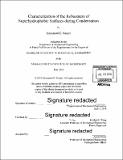Characterization of the robustness of superhydrophobic surfaces during condensation
Author(s)
Simpri, Emmanuel E
DownloadFull printable version (6.689Mb)
Other Contributors
Massachusetts Institute of Technology. Department of Mechanical Engineering.
Advisor
Evelyn N. Wang.
Terms of use
Metadata
Show full item recordAbstract
Condensation is a process utilized by about 85% of power plants in their power generation cycles. Superhydrophobic surfaces can potentially improve the heat transfer due to condensation when compared to the untreated surfaces typically used in condensers. This can improve the efficiency of power plants by up to 3%. These surfaces are made by combining nanoscale roughness with chemical hydrophobicity, and can promote the mode of condensation that has the least resistance to heat transfer. However, it is unclear how long these surfaces will last under industrial conditions. This thesis is focused on testing the robustness of the surfaces in multiple experiments and analyzing the data gathered from these experiments, along with theorizing the mechanism behind any surface functionality deterioration that may be seen. Hydrophobic and superhydrophobic surface samples that have been prepared previously were subjected to water immersion and continuous condensation tests. For the water immersion tests, samples were submerged in water under neutral (pH = 7) and basic (pH = 10) conditions at room (~25°C) and elevated (~50°C) temperatures. The continuous condensations tests were run at a steam temperature of 27°C as well as 100°C. To understand the change in surface properties over the duration of the tests, the surface contact angle was chosen as the metric to be measured. The contact angles of water droplets on the samples were taken beforehand and throughout the tests using a micro-goniometer in order to quantify the change in surface functionality. The data gathered from these experiments were processed in Matlab to produce plots of the change in contact angle over the duration of each test. These plots showed significant contact angle decreases for the hydrophobic surfaces but little change in the contact angle for the superhydrophobic surfaces. This suggests that the addition of nanostructures on the surface, and thus the promotion of super- hydrophobicity, inhibits the surface functionality deterioration mechanism that is seen with the hydrophobic surfaces.
Description
Thesis: S.B., Massachusetts Institute of Technology, Department of Mechanical Engineering, 2016. Cataloged from PDF version of thesis. Includes bibliographical references (page 30).
Date issued
2016Department
Massachusetts Institute of Technology. Department of Mechanical EngineeringPublisher
Massachusetts Institute of Technology
Keywords
Mechanical Engineering.